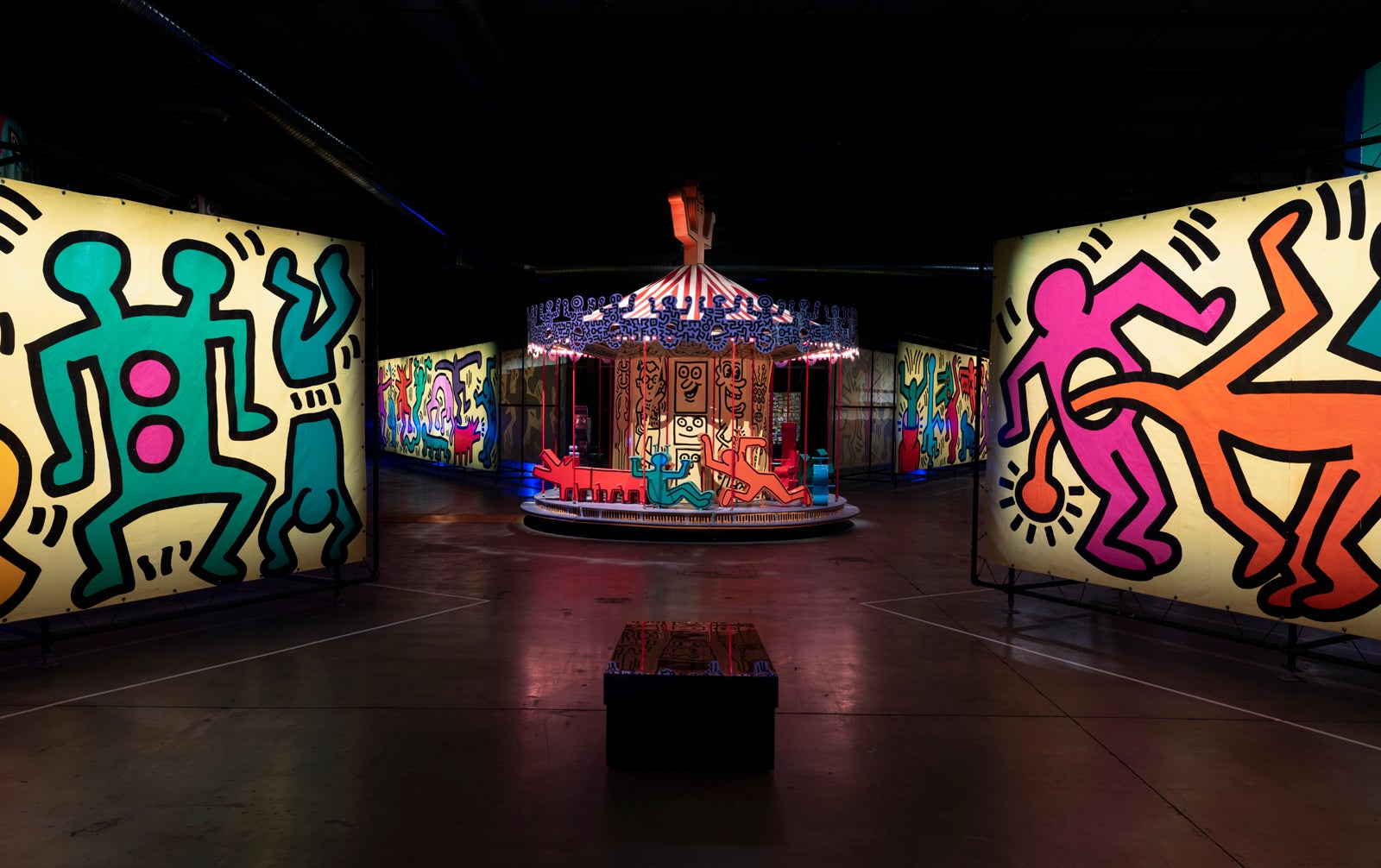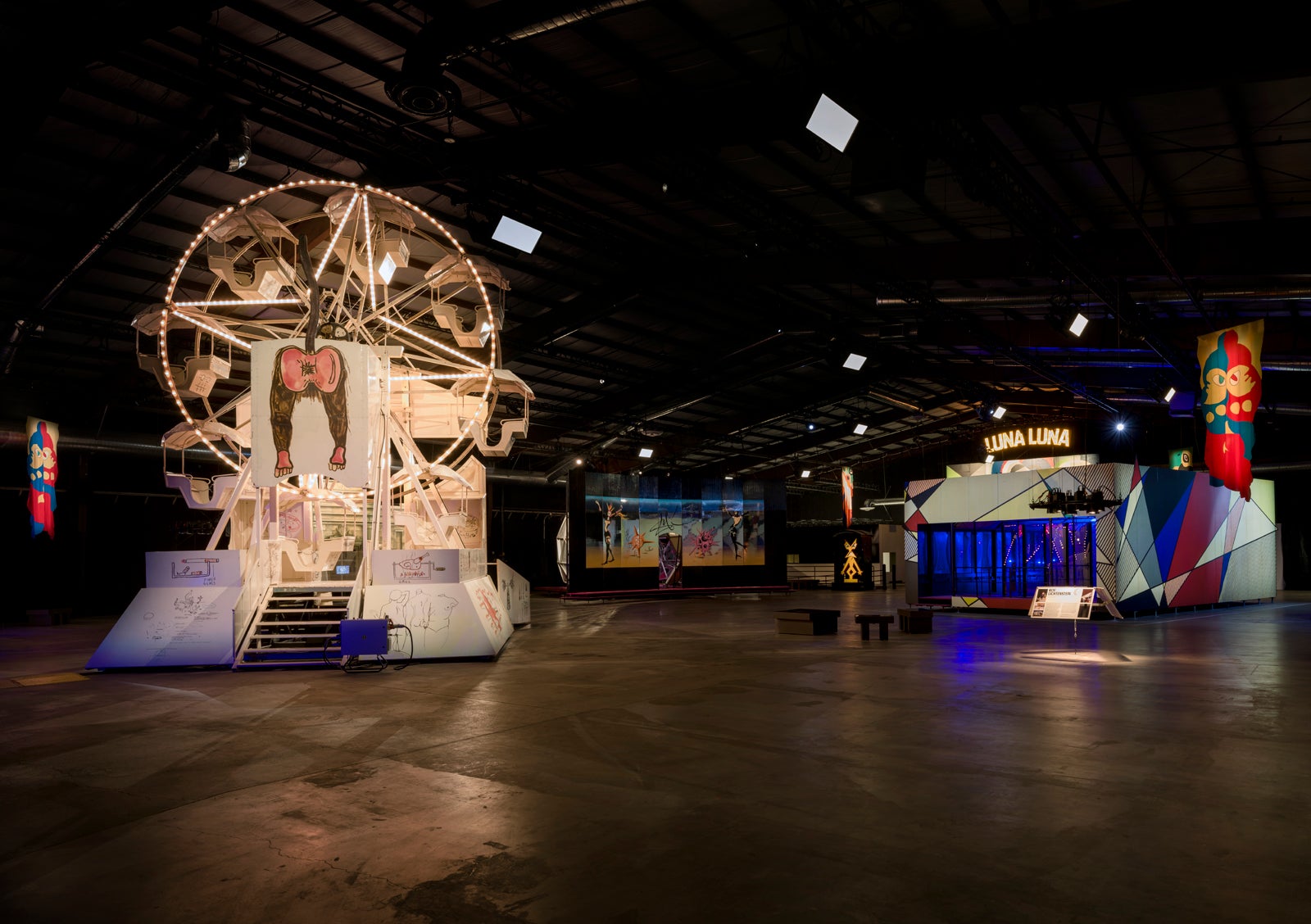Luna Luna review: Lost carnival designed by Basquiat, Dali and Hockney is the art event of the year
The Luna Luna fairground, which first opened in Germany in 1987, has been resurrected by Drake in Los Angeles after decades forgotten in shipping containers. Kevin EG Perry explores a magical exhibition featuring playful, immersive work from some of the greatest artists of the 20th century

Luna Luna, like a dream, almost vanished from memory. In 1987, in Hamburg, the Austrian pop-star-turned-artist André Heller threw open the gates of a one-of-a-kind fairground. Inside, wandering circus acts performed in front of carousels and carnival rides designed by a crew of the greatest artists of their time. Some were already world famous, like Salvador Dalí, David Hockney and Roy Lichtenstein. Others were eccentric Europeans or the rising stars of the New York street art scene: Jean-Michel Basquiat, Kenny Scharf and Keith Haring. That summer, 300,000 lucky visitors swarmed into the park, immersing themselves in colourful, radical, witty, sometimes scatological art. Then, like a circus leaving town, Luna Luna packed up and disappeared.
Heller had grand plans for his attractions to tour the world, but they never came to pass. Instead, Luna Luna ended up in storage, packed inside 44 hulking shipping containers somewhere in sun-bleached Texas. There it stayed for the next 35 years, forgotten by the art history books, with scarcely a mention online. Eventually, a few of those who remembered got word of its existence to Drake, whose entertainment company DreamCrew had the right combination of financial muscle (to the tune of $100m), live events experience and art nous to bring Luna Luna back to life. “Within a 30-second conversation of ‘this existed’, we were all in,” DreamCrew’s Anthony Gonzales told The New York Times about the moment he took the idea to the rapper. “‘How do we get involved?’”
The first job was to open up the storage containers, and find out what state the contents were in after those decades in the desert. They were flown to California, where investors gritted their teeth and held their breath. When the doors were cracked, the production crew found snakes, scorpions and, miraculously, a well-preserved art dreamland still neatly packed away.
So now here it is, back from the memory hole. In a cavernous warehouse in downtown Los Angeles, an exhibition titled Luna Luna: Forgotten Fantasy presents the lovingly restored jewels of this long-buried treasure. It is a wonderful way to spend a couple of hours, in the literal sense: it is a place that induces a childlike sense of wonder. On the day we visit, it’s busy with a mix of ages, but everyone seems to wear a curious, delighted smile. It brings to mind Kurt Vonnegut’s old line: “If this isn’t nice, I don’t know what is.”
You get a sense of what you’re in for before you even make it inside the building: outside in the car park you enter the space through a recreation of Heller’s own inflatable Dream Station. It looks a little like a bouncy castle version of a Dalek, a promising gateway to a new world.
Inside, you’re greeted by Kenny Scharf’s painted swing chair ride and a host of sculptures, based on his psychedelic graffiti faces, that grimace and gurn like oversized cartoon characters. Beside them is a sublime carousel designed by the Austrian painter Arik Brauer. It’s laden with fantastical creatures such as the “pferdehand” (“pferd” is German for “horse”), an orangey-brown hand with index finger outstretched and the legs of a steed, wearing a saddle. One of the few disappointments about Forgotten Fantasy is that, given the modern value of these art pieces, you’re no longer allowed to ride the pferdehand, or anything else for that matter.
The highlight is surely Jean-Michel Basquiat’s painted ferris wheel, which springs to life every so often to the strains of Miles Davis’s 1986 song ‘Tutu’
However you are, so long as you pay extra for a VIP Moon Pass, allowed to have a nose around inside David Hockney’s Enchanted Tree pavilion. An installation based on scenery he originally created for a 1981 staging of Maurice Ravel’s opera The Child and the Spells, it initially doesn’t look like all that much. Then the light show begins outside, and a recording of the Berlin Philharmonic playing exuberant waltzes by Johann II and Josef Strauss starts up, and suddenly you’re a child again, picking your way through a towering forest.
If Hockney’s work invokes the innocence of childhood, then Austrian artist Manfred Deix’s Palace of the Winds is a gift for the sniggering school kid in all of us. Back in the Eighties, Deix created a marquee for Luna Luna custom-designed for the performance of amplified farting accompanied by classical violin. Here, we’re presented with the gorgeously illustrated murals to flatulence that decorated the venue’s proscenium, along with TV screens showing a concert violinist and a couple of bare-cheeked flatulists letting rip in an approximation of Strauss’ “The Blue Danube” waltz. It’s joyful to watch, perhaps because of the juxtaposition of highbrow and lowbrow art, or because it’s always funny to see an arse address a microphone.
Elsewhere, in a video installation about the history of Luna Luna, Keith Haring mentions that when Heller first approached him he asked him if he wanted to “do something for kids”. Haring was delighted by the idea. The artist loved amusement parks, and would go on to call his involvement a “fantasy project”. He flew to Germany to work with the German ride designer Peter Petz, hand-painting his signature characters and creating 3D versions of his crawling babies, crocodiles and dog-men. Again, it’s just a shame you can’t climb aboard like you could in the Eighties. Today, we have to make do with the fact that Haring’s enormous industrially fabricated tarps, which once made great backdrops for park performers, are even better suited to the age of Instagram.
In the exhibition’s second large room, we find more monumental works, including Salvador Dalí’s Dalídom pavilion, a geodesic dome with a mirrored interior that you can clamber inside in order to snatch a kaleidoscopic glimpse of infinity, with an ambient soundtrack of Gregorian chants by Blue Chip Orchestra. Then there’s Roy Lichtenstein’s Luna Luna Pavilion, a glass labyrinth encased in Lichtenstein-designed panels with a soundtrack by the Minimalist composer Philip Glass.

The highlight, though, is surely Jean-Michel Basquiat’s painted ferris wheel, which springs to life every so often to the strains of Miles Davis’s 1986 song “Tutu”. As Luna lore has it, it was only after Heller secured the rights to have Davis soundtrack the ride that Basquiat agreed to design it. The antique wooden wheel, which dates from 1933, was then painted by Viennese artisans in accordance with Basquiat’s instruction and design, the only time the artist ever remotely executed a work. It ended up covered with his idiosyncratic slogans (“BLEEDING FINGERS”, “PORNOGRAPHY”) and cartoonish street art illustrations of plates of spaghetti and dazed dogs. On the back of the wheel, another touch of the obscene: the wheel seems to spin around a monkey’s rear end, tail up, butthole exposed to the world.
It’s only fitting, then, that the exhibition should come to an end with the Swiss artist Daniel Spoerri’s Crap Chancellery. Back in Hamburg, it was used as the entrance to the toilets. The facade is modelled to look like Albert Speer’s designs for Adolf Hitler’s Reich Chancellery, an architectural symbol of Nazi grandeur and power. The artist mockingly drags Speer’s neoclassical design down into the muck, with huge mounds of plastic excrement displayed on columns. Spoerri, whose own father was murdered by Nazis in World War II, mercilessly mocks the fascist aesthetic. Like much of Luna Luna, it is grand, silly and lewd, yet strangely moving to see in its full glory. Like this magical fairground that came so close to slipping into obscurity, the value of taking a s*** on the Nazis should never be forgotten.
‘Luna Luna: Forgotten Fantasy’ is open now at 1601 E 6th St, Los Angeles. For tickets and more information, list lunaluna.com
Join our commenting forum
Join thought-provoking conversations, follow other Independent readers and see their replies
Comments
Bookmark popover
Removed from bookmarks